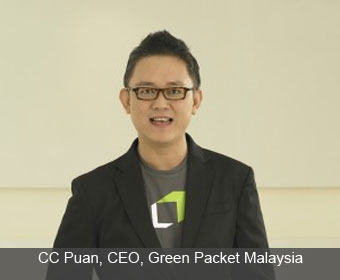WiMAX Vision speaks to CC Puan, CEO of Green Packet Malaysia, and MD of the Green Packet Group, about the firm's WiMAX interests as both supplier and operator.


ccpuan
WiMAX Vision speaks to CC Puan, CEO of Green Packet Malaysia, and MD of the Green Packet Group, about the firm’s WiMAX interests as both supplier and operator.
How did Green Packet start?
I co-founded Green Packet, headquartered in Silicon Valley, in late 1999. We started off as a software and solutions developer to enable the convergence of multiple networks through seamless integration. We help operators solve network problems and increase ARPU, mainly in the mobile broadband space.
Why did you set up operations in Malaysia?
After the dotcom crash, we couldn’t get any more funding. But looking at the solutions we had been developing, we still felt we had huge potential. And the Malaysian government had been doing many things to promote multimedia and technology development [through the Malaysian Multimedia Super Corridor project] and to attract foreign companies to set up their base in Malaysia. So I decided to scale down the US operations, focus on the Asia-Pac market, and move the HQ to Malaysia. Our first major operator contract to sell our solutions to was China Telecom. We then took the company [Green Packet Berhad] public in May 2005.
Why did you branch out into the operator side by acquiring a 2.3GH WiMAX licence in Malaysia and setting up Packet One (P1)?
While we were doing a lot of business in Asia, the Malaysian government was keen that we help them with their goal to reach 50 percent of the population with broadband by 2010. There is a high pent-up demand for broadband in Malaysia, so we thought why not? It has a PC penetration close to 30 percent [in a population of around 28 million] but around two million of those PCs are connected with dial-up rates of 56Kbps. There is a lot of low-hanging fruit for fixed broadband. So we went to the financial markets and raised nearly $100m as part of our bid and, in March 2007, we were awarded one of the 2.3GHz WiMAX licences.
What are the WiMAX rollout plans for P1?
The first phase is to have 1,800 base stations using 600 sites – three base stations per site – to support coverage of 25 percent of the population. We started commercial launch in August 2008 using Alcatel-Lucent equipment but now we are starting on the second phase, with equipment from ZTE, to cover 40 percent of the population, which requires 3,000 base stations and 1,000 sites. We anticipate finishing that by the end of H1 2010. By the end of this year, we are confident we will have 2,100 base stations as compared with about 1,000 base stations now. If you look at the network and subscriber growth for P1, we are moving at a fairly remarkable rate.
What about P1 subscriber numbers?
We had 10,000 subscribers at the end of last year. At the end of 1Q 2009, the net subscriber additions were more than double compared with the last four months of 2008. We see that growth trend continuing and we expect to have 250,000 subscribers by the end of this year.
Is there any conflict of interest between being an operator and an equipment supplier in the same market?
The group strategy is to spin-off the service provider. We have a plan to IPO P1 within the next three years. To have an interest in an operator may have a worse impact in a country where we are a [direct] competitor to our customers. That’s why, in the longer term, we plan to spin-off P1. At the moment, we don’t see much impact on the solutions business [by owning P1]. We do sell solutions, however, to 3G operators in Malaysia.
What do you sell to the mobile operators?
The main product is our connection manger platform, which is used to achieve fixed mobile convergence and seamless integration across multiple networks. The 3G operators, after they upgraded to HSPA networks, have been selling a lot of data cards. But their networks are getting quickly overloaded, so they are in a bit of a dilemma. What we do is provide a connection manger that can offload traffic from 3G onto cheaper wifi networks where it is available. The seamless connectivity is a unique aspect of our solution. We’ve also built a lot of widget-based applications into the connection manager, which is getting a lot interest from both the 3G and WiMAX operators.
How have you helped P1?
At the time P1 got its licence at 2.3GHz, there were very few devices available. So, to ensure P1 success, we also invested in a big team based in Taiwan to help us develop all the devices – USBs, data cards and CPE. We also have WiMAX devices for the 2.5GHz and 3.5GHz frequency bands.
What about WiMAX CPE costs? How far can they be driven down?
The first thing to say is that WiMAX is an open platform based on open standards. But as we are still in the early days of the technology, there are still long IOT [processes] to go through. But the maturity of the WiMAX ecosystem is unprecedented in that it is happening so fast. The 802.16e standard was not ratified until late 2005 but the price of the CPE has gone from between $250 to $300 in 2007 to under $100 today across each of the WiMAX standardised bands. And the price of the USB dongle today is cheaper than a HSPA modem. The maturity of the WiMAX ecosystem in terms of device prices and variety is really remarkable. And one of the advantages of the open standard is that it doesn’t have the IPR and royalty issues related to CDMA and the future LTE. I think it’s possible to get simple WiMAX CPE [no voice or wifi] below $70 by the end of this year.
What is the cost difference between an HSPA and USB dongle today?
There are royalty payments on HSPA, which range from a few US dollars to tens of US dollars depending on the volume, which has to be added to the cost of the chipset. But WiMAX chipsets are now under $20 [with no royalty payments], so it probably costs about $15 to $20 more for a 3G chipset. There are more than 20 WiMAX chipset companies compared with CDMA, which is mainly a Qualcomm play.
How many WiMAX CPE units are you shipping?
We’re probably looking at between 700,000 to 800,000 units this year [including dongles], which is about 7-8 percent of the total market share. Apart from Malaysia, which we estimate at around 250,000 [with P1] this year, we already have global reseller CPE partnerships with Alcatel-Lucent and Huawei.
How do you see the WiMAX device market developing?
I think it will be in four stages. The first stage is fixed-line services and CPE, followed in the second stage by nomadic services with USBs and embedded devices. The third stage is mobile handsets, and the fourth stage is embedded CE devices and M2M applications.
Why have you set up a WiMAX operator consultancy business?
We want not only to be a WiMAX operator in Malaysia but also a regional player, so we have set up another arm called P1 International. It is designed to help aspiring WiMAX operators have a quicker time-to-market by leverage our experience.
Read more about:
DiscussionAbout the Author(s)
You May Also Like








.png?width=300&auto=webp&quality=80&disable=upscale)


_1.jpg?width=300&auto=webp&quality=80&disable=upscale)


.png?width=800&auto=webp&quality=80&disable=upscale)